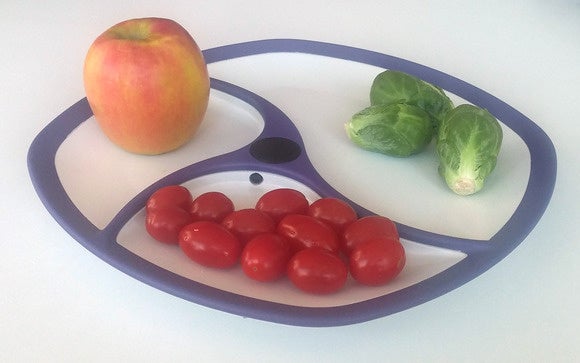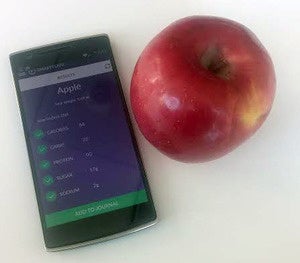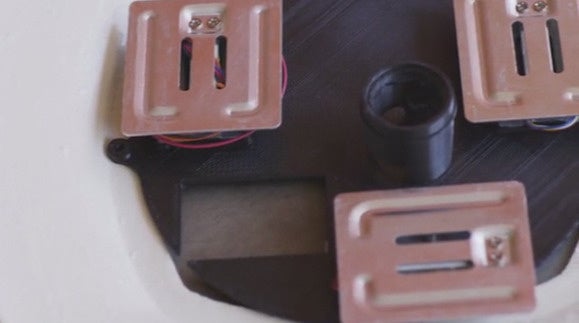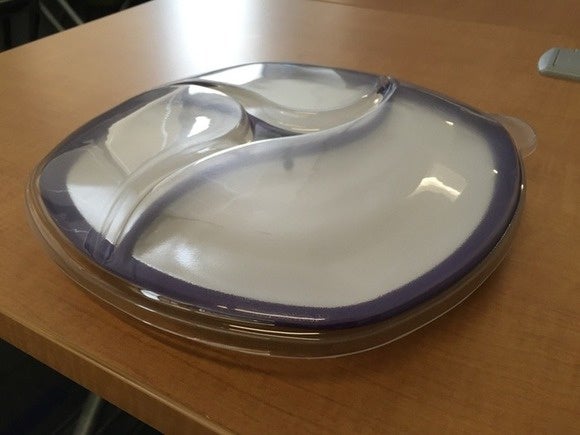
Given my evisceration of the absurd Vessyl smart cup, I have to commend Fitly for being brave enough to show me its SmartPlate. Toss in the HAPIlabs’ smart fork, and you would appear to have the most ridiculous table setting in the world.
Because do I really want my tableware to be “smart”? Do I want it to win on Jeopardy? Do I want it to graduate from MIT? All these smart products just make human innovation sound dumb.
But while the basic premise of a “smart” plate sounds ludicrous, Fitly’s vision for its just-Kickstarted SmartPlate isn’t entirely laughable. The core benefits Fitly promises might actually prove useful to certain groups of people—assuming the SmartPlate works as advertised, accurately and consistently pulling off all the magic tricks it promises.
Am I Alfredo or marinara?

The plate is divided into three partitions. Load sensors report how much your food weighs (up to three pounds total), while cameras married to object-recognition technology determine what you’re actually eating. So let’s say you plop grandma’s meat loaf on one section, mashed potatoes with butter on another section, and green beans on the third. Fitly says the SmartPlate will visually determine each food, weigh the portions, and then report back calorie and nutritional data via a smartphone app.
Note that the system doesn’t use molecular analysis like, say, a SCIO sensor. Instead it determines what you’re about to eat by looking at the subtle colors and patterns of your food (so mashed potatoes with butter would conceivably read differently than mashed potatoes sans “let’s make this palatable” dairy products). Fitly says that its advanced optical recognition is showing 99 percent accuracy with many foods, and can determine the difference between white bread and wheat bread, and pasta with marinara sauce and pasta Alfredo.
Fitly says the SmartPlate also uses advanced machine learning to better identify foods as more and more people use the platform. All user data will float in the cloud in a single database, so as more food patterns are established, the better the optical recognition will be for all.
Advanced machine learning
I met with Fitly to see the SmartPlate in action. In a very controlled setting, the plate did indeed identify the pedigree and weight of an apple, and could tell the difference between wheat and white bread. But what about really challenging foods like lasagna? How will Fitly’s algorithms know the difference between vegetable and meat varieties?

The company says it’s confident that machine learning and it’s already advanced optical-recognition tech can suss out the subtle differences between chunks of zucchini and ground beef. But I was also cautioned that you can’t simply plop a wrapped burrito on top of the SmartPlate and expect a miracle calorie report. Instead, you have to cut that burrito in half and point a cross-section at the camera sensor.
Oh, and there’s also a display in the middle of the plate. It can tell you to slow down if you’re eating too fast.
The SmartPlate will still need gentle cleaning between every meal (obviously), and it’s not microwavable (obviously). So the prospect of making it your single everyday plate smacks a bit impractical. Still, a plate with accurate, consistent and highly advanced weight and ingredients recognition could prove useful to some.

Competitive athletes might use such a plate to fine-tune their diets. Diabetics might use such a plate to closely monitor carbohydrate intake. And those on a low-sodium diet might use such a plate to receive warnings about food with too much salt. Perhaps best of all, if the platform really works as advertised, consumers willing to use such a plate for each and every meal will no longer have to struggle with the pain and friction of food-logging apps.
Now, is the Fitly SmartPlate really the hardware to deliver on all these claims? It’s promising a lot, and consumers already have reason to doubt the veracity of optical recognition. Exhibit A: The laugable results of Microsoft’s just-released How-Old.net engine. Indeed, the SmartPlate sounds like something (and even looks a bit like something) you’d see on the original Star Trek.
If you’re willing to take a gamble on Fitly actually delivering on all its claims, you can get in on $99 early bird pricing. The magic tableware is slated to ship next summer. I won’t be spending any of my money on smart tableware any time soon, but I do think this platform looks a bit less dumb than last year’s smart cup.
[ Source :- Techhive ]







